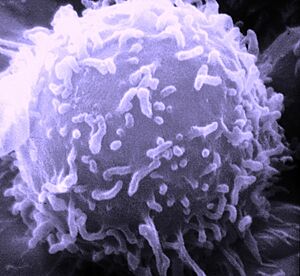Adaptive immune system facts for kids
The adaptive immune system is like your body's special defense team. It uses specific cells and methods to find and destroy harmful germs, called pathogens. It also helps prevent them from attacking you in the first place.
This smart defense system gets activated by your body's older, more general defense system, called the innate immune system. While the innate system fights anything that looks foreign, the adaptive system learns to target very specific invaders.
You can find the innate immune system in almost all animals. But the adaptive system is only found in animals with backbones, like us! Scientists believe it first appeared in the earliest animals with jaws.
The adaptive immune system helps your body's immune system remember specific pathogens. This means that each time you meet a certain germ, your body can fight it off even better and faster. It's called adaptive because your immune system learns and prepares for future challenges.
Contents
How Your Body Defends Itself
Your immune system protects you from infections with different layers of defense.
Physical Barriers
First, your body has physical barriers. These are like walls that stop germs such as bacteria and viruses from getting inside you. Think of your skin as a big protective barrier!
The Innate Immune System
If a germ manages to get past these barriers, your innate immune system kicks in. This system gives an immediate response. It acts quickly, but it's not specific to one type of germ. Innate immune systems are found in all plants and animals.
The Adaptive Immune System
If germs manage to get past the innate response, then the adaptive immune system steps in. This is the third layer of protection for animals with backbones. The innate system actually helps to activate the adaptive system.
The adaptive system learns and improves its response during an infection. It gets better at recognizing the specific germ. After the germ is defeated, special cells called B and T cells remain. They are ready for a faster response next time. This is like your body having an "immunological memory". These memory cells help the adaptive immune system launch quicker and stronger attacks if the same germ tries to invade again.
| Innate Immune System | Adaptive Immune System |
|---|---|
| Fights all kinds of germs generally | Fights specific germs and antigens |
| Reacts right away | Takes some time to react fully |
| Uses general cell and fluid defenses | Uses specific T lymphocytes and antibodies |
| Does not remember past germs | Remembers past germs for faster future responses |
| Found in almost all living things | Found only in animals with jaws |
Both the innate and adaptive immune systems need to tell the difference between "self" and "non-self" molecules. "Self" molecules are parts of your own body. "Non-self" molecules are foreign substances. One type of non-self molecule is called an antigen. Antigens are substances that trigger an immune response. They bind to special immune receptors in your body.
What the Adaptive Immune System Does
The adaptive immune system starts working when a germ gets past the innate immune system. It needs a certain amount of antigens to be present to get activated.
The main jobs of your adaptive immune system are:
- Recognizing invaders: It finds specific "non-self" antigens while ignoring your own body's "self" parts. This happens through a process called antigen presentation. Here, special cells like macrophages and dendritic cells show antigens to T cells so they can recognize them.
- Targeted attacks: It creates responses that are perfectly designed to get rid of specific germs or infected cells.
- Building memory: It develops immunological memory. This means each germ is "remembered" by a unique antibody. These memory cells can be quickly called upon to fight off the germ if it tries to infect you again.
| How you get it naturally | How you get it artificially (like from a doctor) |
|---|---|
| Active- Germs enter your body naturally, and you fight them off. | Active- Antigens are put into your body through vaccines. |
| Passive- Antibodies pass from a mother to her baby through the placenta or breast milk. | Passive- Ready-made antibodies are given to you by injection. |
Images for kids
See also
 In Spanish: Sistema de inmunidad adquirida para niños
In Spanish: Sistema de inmunidad adquirida para niños



